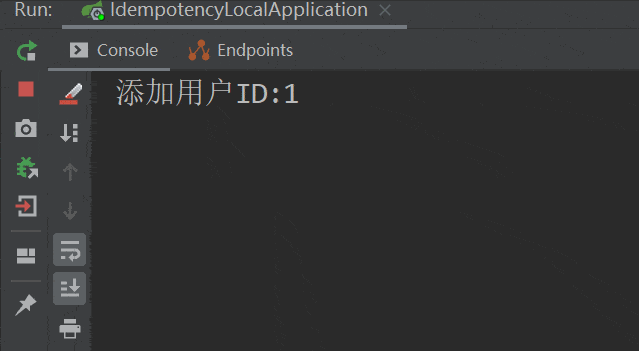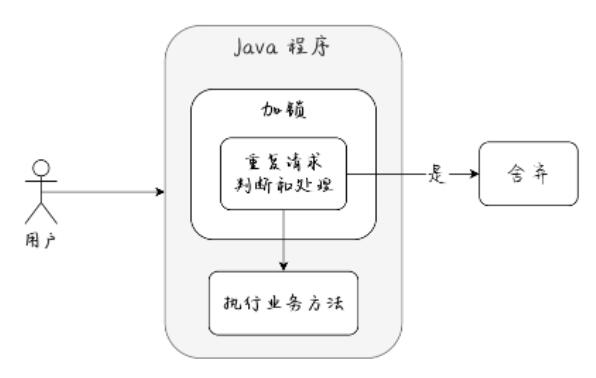

最简单的六种防止数据重复提交的方法!
source link: https://www.fly63.com/article/detial/11584
Go to the source link to view the article. You can view the picture content, updated content and better typesetting reading experience. If the link is broken, please click the button below to view the snapshot at that time.
扫一扫分享
有位朋友,某天突然问磊哥:在 Java 中,防止重复提交最简单的方案是什么?
这句话中包含了两个关键信息,第一:防止重复提交;第二:最简单。
于是磊哥问他,是单机环境还是分布式环境?
得到的反馈是单机环境,那就简单了,于是磊哥就开始装*了。
话不多说,我们先来复现这个问题。
模拟用户场景
根据朋友的反馈,大致的场景是这样的,如下图所示:

简化的模拟代码如下(基于 Spring Boot):
import org.springframework.web.bind.annotation.RequestMapping;
import org.springframework.web.bind.annotation.RestController;
@RequestMapping("/user")
@RestController
public class UserController {
/**
* 被重复请求的方法
*/
@RequestMapping("/add")
public String addUser(String id) {
// 业务代码...
System.out.println("添加用户ID:" + id);
return "执行成功!";
}
}于是磊哥就想到:通过前、后端分别拦截的方式来解决数据重复提交的问题。
前端拦截
前端拦截是指通过 html 页面来拦截重复请求,比如在用户点击完“提交”按钮后,我们可以把按钮设置为不可用或者隐藏状态。
前端拦截的实现代码:
<html>
<script>
function subCli(){
// 按钮设置为不可用
document.getElementById("btn_sub").disabled="disabled";
document.getElementById("dv1").innerText = "按钮被点击了~";
}
</script>
<body style="margin-top: 100px;margin-left: 100px;">
<input id="btn_sub" type="button" value=" 提 交 " onclick="subCli()">
<div id="dv1" style="margin-top: 80px;"></div>
</body>
</html>但前端拦截有一个致命的问题,如果是懂行的程序员或非法用户可以直接绕过前端页面,通过模拟请求来重复提交请求,比如充值了 100 元,重复提交了 10 次变成了 1000 元(瞬间发现了一个致富的好办法)。
所以除了前端拦截一部分正常的误操作之外,后端的拦截也是必不可少。
后端拦截的实现思路是在方法执行之前,先判断此业务是否已经执行过,如果执行过则不再执行,否则就正常执行。
我们将请求的业务 ID 存储在内存中,并且通过添加互斥锁来保证多线程下的程序执行安全,大体实现思路如下图所示:

然而,将数据存储在内存中,最简单的方法就是使用 HashMap 存储,或者是使用 Guava Cache 也是同样的效果,但很显然 HashMap 可以更快的实现功能,所以我们先来实现一个 HashMap 的防重(防止重复)版本。
1、基础版——HashMap
import org.springframework.web.bind.annotation.RequestMapping;
import org.springframework.web.bind.annotation.RestController;
import java.util.HashMap;
import java.util.Map;
/**
* 普通 Map 版本
*/
@RequestMapping("/user")
@RestController
public class UserController3 {
// 缓存 ID 集合
private Map<String, Integer> reqCache = new HashMap<>();
@RequestMapping("/add")
public String addUser(String id) {
// 非空判断(忽略)...
synchronized (this.getClass()) {
// 重复请求判断
if (reqCache.containsKey(id)) {
// 重复请求
System.out.println("请勿重复提交!!!" + id);
return "执行失败";
}
// 存储请求 ID
reqCache.put(id, 1);
}
// 业务代码...
System.out.println("添加用户ID:" + id);
return "执行成功!";
}
}存在的问题:此实现方式有一个致命的问题,因为 HashMap 是无限增长的,因此它会占用越来越多的内存,并且随着 HashMap 数量的增加查找的速度也会降低,所以我们需要实现一个可以自动“清除”过期数据的实现方案。
2、优化版——固定大小的数组
此版本解决了 HashMap 无限增长的问题,它使用数组加下标计数器(reqCacheCounter)的方式,实现了固定数组的循环存储。
当数组存储到最后一位时,将数组的存储下标设置 0,再从头开始存储数据,实现代码如下:
import org.springframework.web.bind.annotation.RequestMapping;
import org.springframework.web.bind.annotation.RestController;
import java.util.Arrays;
@RequestMapping("/user")
@RestController
public class UserController {
private static String[] reqCache = new String[100]; // 请求 ID 存储集合
private static Integer reqCacheCounter = 0; // 请求计数器(指示 ID 存储的位置)
@RequestMapping("/add")
public String addUser(String id) {
// 非空判断(忽略)...
synchronized (this.getClass()) {
// 重复请求判断
if (Arrays.asList(reqCache).contains(id)) {
// 重复请求
System.out.println("请勿重复提交!!!" + id);
return "执行失败";
}
// 记录请求 ID
if (reqCacheCounter >= reqCache.length) reqCacheCounter = 0; // 重置计数器
reqCache[reqCacheCounter] = id; // 将 ID 保存到缓存
reqCacheCounter++; // 下标往后移一位
}
// 业务代码...
System.out.println("添加用户ID:" + id);
return "执行成功!";
}
}3、扩展版——双重检测锁(DCL)
上一种实现方法将判断和添加业务,都放入 synchronized 中进行加锁操作,这样显然性能不是很高,于是我们可以使用单例中著名的 DCL(Double Checked Locking,双重检测锁)来优化代码的执行效率,实现代码如下:
import org.springframework.web.bind.annotation.RequestMapping;
import org.springframework.web.bind.annotation.RestController;
import java.util.Arrays;
@RequestMapping("/user")
@RestController
public class UserController {
private static String[] reqCache = new String[100]; // 请求 ID 存储集合
private static Integer reqCacheCounter = 0; // 请求计数器(指示 ID 存储的位置)
@RequestMapping("/add")
public String addUser(String id) {
// 非空判断(忽略)...
// 重复请求判断
if (Arrays.asList(reqCache).contains(id)) {
// 重复请求
System.out.println("请勿重复提交!!!" + id);
return "执行失败";
}
synchronized (this.getClass()) {
// 双重检查锁(DCL,double checked locking)提高程序的执行效率
if (Arrays.asList(reqCache).contains(id)) {
// 重复请求
System.out.println("请勿重复提交!!!" + id);
return "执行失败";
}
// 记录请求 ID
if (reqCacheCounter >= reqCache.length) reqCacheCounter = 0; // 重置计数器
reqCache[reqCacheCounter] = id; // 将 ID 保存到缓存
reqCacheCounter++; // 下标往后移一位
}
// 业务代码...
System.out.println("添加用户ID:" + id);
return "执行成功!";
}
}注意:DCL 适用于重复提交频繁比较高的业务场景,对于相反的业务场景下 DCL 并不适用。
4、完善版——LRUMap
上面的代码基本已经实现了重复数据的拦截,但显然不够简洁和优雅,比如下标计数器的声明和业务处理等,但值得庆幸的是 Apache 为我们提供了一个 commons-collections 的框架,里面有一个非常好用的数据结构 LRUMap 可以保存指定数量的固定的数据,并且它会按照 LRU 算法,帮你清除最不常用的数据。
小贴士:LRU 是 Least Recently Used 的缩写,即最近最少使用,是一种常用的数据淘汰算法,选择最近最久未使用的数据予以淘汰。
首先,我们先来添加 Apache commons collections 的引用:
<!-- 集合工具类 apache commons collections -->
<!-- https://mvnrepository.com/artifact/org.apache.commons/commons-collections4 -->
<dependency>
<groupId>org.apache.commons</groupId>
<artifactId>commons-collections4</artifactId>
<version>4.4</version>
</dependency>实现代码如下:
import org.apache.commons.collections4.map.LRUMap;
import org.springframework.web.bind.annotation.RequestMapping;
import org.springframework.web.bind.annotation.RestController;
@RequestMapping("/user")
@RestController
public class UserController {
// 最大容量 100 个,根据 LRU 算法淘汰数据的 Map 集合
private LRUMap<String, Integer> reqCache = new LRUMap<>(100);
@RequestMapping("/add")
public String addUser(String id) {
// 非空判断(忽略)...
synchronized (this.getClass()) {
// 重复请求判断
if (reqCache.containsKey(id)) {
// 重复请求
System.out.println("请勿重复提交!!!" + id);
return "执行失败";
}
// 存储请求 ID
reqCache.put(id, 1);
}
// 业务代码...
System.out.println("添加用户ID:" + id);
return "执行成功!";
}
}使用了 LRUMap 之后,代码显然简洁了很多。
5、最终版——封装
以上都是方法级别的实现方案,然而在实际的业务中,我们可能有很多的方法都需要防重,那么接下来我们就来封装一个公共的方法,以供所有类使用:
import org.apache.commons.collections4.map.LRUMap;
/**
* 幂等性判断
*/
public class IdempotentUtils {
// 根据 LRU(Least Recently Used,最近最少使用)算法淘汰数据的 Map 集合,最大容量 100 个
private static LRUMap<String, Integer> reqCache = new LRUMap<>(100);
/**
* 幂等性判断
* @return
*/
public static boolean judge(String id, Object lockClass) {
synchronized (lockClass) {
// 重复请求判断
if (reqCache.containsKey(id)) {
// 重复请求
System.out.println("请勿重复提交!!!" + id);
return false;
}
// 非重复请求,存储请求 ID
reqCache.put(id, 1);
}
return true;
}
}调用代码如下:
import com.example.idempote.util.IdempotentUtils;
import org.springframework.web.bind.annotation.RequestMapping;
import org.springframework.web.bind.annotation.RestController;
@RequestMapping("/user")
@RestController
public class UserController4 {
@RequestMapping("/add")
public String addUser(String id) {
// 非空判断(忽略)...
// -------------- 幂等性调用(开始) --------------
if (!IdempotentUtils.judge(id, this.getClass())) {
return "执行失败";
}
// -------------- 幂等性调用(结束) --------------
// 业务代码...
System.out.println("添加用户ID:" + id);
return "执行成功!";
}
}小贴士:一般情况下代码写到这里就结束了,但想要更简洁也是可以实现的,你可以通过自定义注解,将业务代码写到注解中,需要调用的方法只需要写一行注解就可以防止数据重复提交了,老铁们可以自行尝试一下(需要磊哥撸一篇的,评论区留言 666)。
扩展知识——LRUMap 实现原理分析
既然 LRUMap 如此强大,我们就来看看它是如何实现的。
LRUMap 的本质是持有头结点的环回双链表结构,它的存储结构如下:
AbstractLinkedMap.LinkEntry entry;当调用查询方法时,会将使用的元素放在双链表 header 的前一个位置,源码如下:
public V get(Object key, boolean updateToMRU) {
LinkEntry<K, V> entry = this.getEntry(key);
if (entry == null) {
return null;
} else {
if (updateToMRU) {
this.moveToMRU(entry);
}
return entry.getValue();
}
}
protected void moveToMRU(LinkEntry<K, V> entry) {
if (entry.after != this.header) {
++this.modCount;
if (entry.before == null) {
throw new IllegalStateException("Entry.before is null. This should not occur if your keys are immutable, and you have used synchronization properly.");
}
entry.before.after = entry.after;
entry.after.before = entry.before;
entry.after = this.header;
entry.before = this.header.before;
this.header.before.after = entry;
this.header.before = entry;
} else if (entry == this.header) {
throw new IllegalStateException("Can't move header to MRU This should not occur if your keys are immutable, and you have used synchronization properly.");
}
}如果新增元素时,容量满了就会移除 header 的后一个元素,添加源码如下:
protected void addMapping(int hashIndex, int hashCode, K key, V value) {
// 判断容器是否已满
if (this.isFull()) {
LinkEntry<K, V> reuse = this.header.after;
boolean removeLRUEntry = false;
if (!this.scanUntilRemovable) {
removeLRUEntry = this.removeLRU(reuse);
} else {
while(reuse != this.header && reuse != null) {
if (this.removeLRU(reuse)) {
removeLRUEntry = true;
break;
}
reuse = reuse.after;
}
if (reuse == null) {
throw new IllegalStateException("Entry.after=null, header.after=" + this.header.after + " header.before=" + this.header.before + " key=" + key + " value=" + value + " size=" + this.size + " maxSize=" + this.maxSize + " This should not occur if your keys are immutable, and you have used synchronization properly.");
}
}
if (removeLRUEntry) {
if (reuse == null) {
throw new IllegalStateException("reuse=null, header.after=" + this.header.after + " header.before=" + this.header.before + " key=" + key + " value=" + value + " size=" + this.size + " maxSize=" + this.maxSize + " This should not occur if your keys are immutable, and you have used synchronization properly.");
}
this.reuseMapping(reuse, hashIndex, hashCode, key, value);
} else {
super.addMapping(hashIndex, hashCode, key, value);
}
} else {
super.addMapping(hashIndex, hashCode, key, value);
}
}判断容量的源码:
public boolean isFull() {
return size >= maxSize;
}容量未满就直接添加数据:
super.addMapping(hashIndex, hashCode, key, value);如果容量满了,就调用 reuseMapping 方法使用 LRU 算法对数据进行清除。
综合来说:LRUMap 的本质是持有头结点的环回双链表结构,当使用元素时,就将该元素放在双链表 header 的前一个位置,在新增元素时,如果容量满了就会移除 header 的后一个元素。
本文讲了防止数据重复提交的 6 种方法,首先是前端的拦截,通过隐藏和设置按钮的不可用来屏蔽正常操作下的重复提交。但为了避免非正常渠道的重复提交,我们又实现了 5 个版本的后端拦截:HashMap 版、固定数组版、双重检测锁的数组版、LRUMap 版和 LRUMap 的封装版。
特殊说明:本文所有的内容仅适用于单机环境下的重复数据拦截,如果是分布式环境需要配合数据库或 Redis 来实现。
作者:磊哥
来源: Java中文社群
Recommend
-
 186
186
-
 61
61
背景 前端在向后端进行数据提交的时候,通常会需要在第一次提交返回前,阻止用户在快速点击发送二次请求,即防止重复提交,最简单的方法是使用标志参数或者 class 元素控制,但缺点是,每个控制重复提交的地方都需要加上这个逻辑,重复性太强,且控制逻辑不统一。...
-
 25
25
有位朋友,某天突然问磊哥:在 Java 中,防止重复提交最简单的方案是什么? 这句话中包含了两个关键信息,第一:防止重复提交;第二:最简单。 于是磊哥问他,是单机环境还是分布式环境? 得到的反馈是单机环境,那就简单...
-
 44
44
在MySQL进行数据插入操作时,总是会考虑是否会插入重复数据,之前的操作都是先根据主键或者唯一约束条件进行查询,有就进行更新没有就进行插入。代码反复效率低下。 新建表格 CREATE TABLE `person` ( `id` int...
-
 1
1
表单重复提交是在多用户Web应用中最常见、带来很多麻烦的一个问题。有很多的应用场景都会遇到重复提交问题,比如:点击提交按钮两次。点击刷新按钮。使用浏览器后退按钮重复之前的操作,导致重复提交表单。...
-
 1
1
简单的六种防止数据重复提交的方法!-51CTO.COM
-
 5
5
如何防止接口重复提交? 作者:鸭血粉丝Tang 2022-11-11 07:34:43 对于下单流量不算高的系统,可以采用这种请求唯一ID+数据表增加唯一索引约束的方式,来防止接口重复提交! 对于投入运营的软件系统,最...
-
 3
3
聊聊如何防止接口重复提交? 作者:鸭血粉丝Tang 2022-11-17 07:43:13 本次方案相比于上一个方案,最大的改进点在于:将接口请求唯一 ID 的生成逻辑,放在服务端通过规则组合来实现,不需要前端提交接口的时候强制...
-
 2
2
在上一篇文章中,我们详细的介绍了对于下单流量不算高的系统,可以通过请求唯一ID+数据表增加唯一索引约束这种方案来实现防止接口重复提交! 随着业务的快速增长,每一秒的下单请...
-
 2
2
今天用AI搞一个防止接口重复提交注解 作者:了不起 2023-06-05 08:22:20 人工智能 接口幂等性是指无论调用接口的次数是一次还是多次,对于同...
About Joyk
Aggregate valuable and interesting links.
Joyk means Joy of geeK